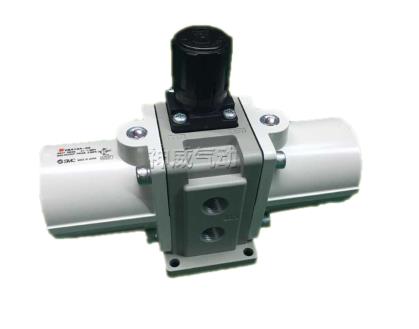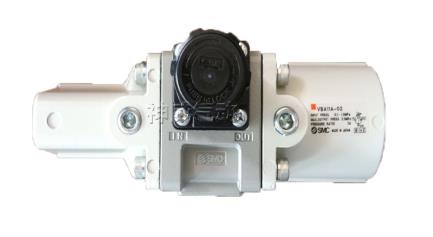The input air pressure is divided into two channels. One channel opens the one-way valve to charge into the boosting chamber A and B of the small cylinder, and the other channel passes through the pressure regulating valve and reversing valve to the large cylinder. The driving chamber B is inflated and the driving chamber A is exhausted. In this way, the large piston moves to the left, driving the small piston to also move to the left. Chamber B of the small cylinder is pressurized, and the one-way valve is opened to send high-pressure gas from the outlet. When the small piston comes to the end, the reversing valve switches, then the drive chamber A takes in air, the drive chamber B exhausts, the big piston moves in reverse, the boosting chamber A pressurizes, opens the one-way valve, and continues to send high-pressure gas from the output port. The above actions only need to be repeated to obtain continuous output of high-pressure gas from the outlet. The outlet pressure is fed back to the pressure regulating valve, which can automatically maintain the outlet pressure at a certain value. When the outlet pressure needs to be changed, the handwheel can be adjusted to obtain any set outlet pressure within the boost ratio range. If the outlet feedback pressure is balanced with the spring force of the pressure regulating valve, The booster valve stops operating and no longer outputs flow.

The gas boosting valve uses compressed air as a power source. It can supercharge the gas without any power supply. It can increase the gas pressure by several to dozens of times. By adjusting the drive The required pressure can be obtained by adjusting the gas pressure. When the gas pressure reaches the set value, the booster pump automatically stops working to save energy. As the high-pressure gas is consumed, the booster pump automatically starts working again. The low-pressure gas at the large-area piston end is used to drive the high-pressure gas at the small-area piston end. Automatic restart - When working, the gas booster reciprocates rapidly. As the output pressure approaches the set pressure value, the reciprocating speed of the pump slows down until it stops. And maintain this pressure, at this time the energy consumption is very small, no heat is generated, and there is no movement of parts. When the pressure balance is broken, the supercharger automatically starts working to the next balance.
Highly adjustable—both pressure and flow are accurately adjusted by the pressure regulating valve that drives the gas. Gas booster valve has a wide range of applications - gas boosters can be used for most non-corrosive gas media. High cost performance-it has the characteristics of high output performance and low cost. Simple maintenance—The gas booster has fewer parts and seals, making maintenance simple and low-cost. High output pressure—the maximum working pressure of the gas booster can reach 30,400psi (210Mpa). Large output flow - the gas booster requires no more than 150psi (1.0Mpa) compressed air to drive to obtain a large output flow. According to different working requirements, there are a variety of gas booster series for users to choose from.

Instructions for use and installation of booster valve:
1) If the outlet pressure of the booster valve exceeds 1.0MPa, the pressure specifications of pipe joints, gas pipelines, gas valves, etc. should be confirmed.
2) Before taking over, the piping should be blown clean.
3) The piston should be installed horizontally. The mounting nuts must be secure. If there is vibration, anti-vibration rubber pads should be installed.
4) Setting of the outlet pressure of the handwheel-operated booster valve. In the off-site state, overflow occurs as soon as air is supplied. You should quickly turn the adjustment handwheel outward and turn it in the direction of the arrow. After the pressure is set, press the handwheel back.
5) Setting of the outlet pressure of the handwheel-operated booster valve. In the factory state, overflow occurs as soon as air is supplied. You should quickly turn the adjustment handwheel outward and turn it in the direction of the arrow. After the pressure is set, press the handwheel back. No need to exceed the setting range. After the pressure is set, to reduce the pressure on the secondary side, use the handwheel to exit (-). When resetting, the pressure should be lowered to the pressure you want to set before proceeding.
6) Setting of the outlet pressure of the pilot pressure control type booster valve. The pilot pressure can be set as half of the outlet pressure when the pilot pressure is present.
7) In exceptional circumstances, if the residual pressure is required to be discharged quickly, a three-way valve can be installed after the booster valve. If set in pressurization valve< /strong>In the front, due to the existence of the one-way valve, the residual pressure cannot be discharged.






 WhatsApp: +8615857777578
WhatsApp: +8615857777578